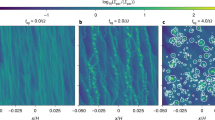Abstract
The Kuiper belt is a disk of icy bodies that orbit the Sun beyond Neptune1; the largest known members are Pluto and its companion Charon. A few per cent of Kuiper-belt bodies have recently been found to be binaries with wide separations and mass ratios of the order of unity2,3,4,5,6,7,8. Collisions were too infrequent to account for the observed number of binaries9, implying that these binaries formed through collisionless interactions mediated by gravity. These interactions are likely to have been most effective during the period of runaway accretion, early in the Solar System's history. Here we show that a transient binary forms when two large bodies penetrate one another's Hill sphere (the region where their mutual forces are larger than the tidal force of the Sun). The loss of energy needed to stabilize the binary orbit can then occur either through dynamical friction from surrounding small bodies, or through the gravitational scattering of a third large body. Our estimates slightly favour the former mechanism. We predict that five per cent of Kuiper-belt objects are binaries with apparent separations greater than 0.2 arcsec, and that most are in tighter binaries or systems of higher multiplicity.

Similar content being viewed by others
References
Luu, J. X. & Jewitt, D. C. Trans-neptunian objects: Relics from the accretion disk of the sun. Annu. Rev. Astron. Astrophys. 40, 63–101 (2002)
Elliot, J. L., Kern, S. D., Osip, D. J. & Burles, S. M. 2001 QT_297. IAU Circ. No. 7733 (2001).
Kavelaars, J. J., Petit, J.-M., Gladman, B. & Holman, M. 2001 QW_322. IAU Circ. No. 7749 (2001).
Brown, M. E. & Trujillo, C. A. (26308) 1998 SM_165. IAU Circ. No. 7807 (2002).
Trujillo, C. A. & Brown, M. E. 1999 TC_36. IAU Circ. No. 7787 (2002).
Noll, K. et al. 2000 CF_105. IAU Circ. No. 7857 (2002).
Noll, K. et al. 1997 CQ_29. IAU Circ. No. 7824 (2002).
Veillet, C. et al. The binary Kuiper-belt object 1998 WW31. Nature 416, 711–713 (2002)
Stern, S. A. Implications regarding the energetics of the collisional formation of Kuiper belt satellites. Preprint astro-ph/0206104 at 〈xxx.lanl.gov〉 (2002).
Morbidelli, A., Jacob, C. & Petit, J.-M. Planetary embryos never formed in the Kuiper belt. Icarus 157, 241–248 (2002)
Trujillo, C. A., Jewitt, D. C. & Luu, J. X. Properties of the trans-neptunian belt: Statistics from the Canada-France-Hawaii telescope survey. Astron. J. 122, 457–473 (2001)
Gladman, B. et al. Pencil-beam surveys for faint trans-neptunian objects. Astron. J. 116, 2042–2054 (1998)
Chiang, E. I. & Brown, M. E. Keck pencil-beam survey for faint Kuiper belt objects. Astron. J. 118, 1411–1422 (1999)
Kenyon, S. J. & Luu, J. X. Accretion in the early Kuiper belt. I. Coagulation and velocity evolution. Astron. J. 115, 2136–2160 (1998)
Kenyon, S. J. & Luu, J. X. Accretion in the early Kuiper belt. II. Fragmentation. Astron. J. 118, 1101–1119 (1999)
Kenyon, S. J. Planet formation in the outer solar system. Publ. Astron. Soc. Pacif. 114, 265–283 (2002)
Weidenschilling, S. J. On the origin of binary transneptunian objects. Icarus 160, 212–215 (2002)
Binney, J. Dynamical friction in aspherical clusters. Mon. Not. R. Astron. Soc. 181, 735–746 (1977)
Hut, P. & Bahcall, J. N. Binary-single star scattering. I—Numerical experiments for equal masses. Astrophys. J. 268, 319–341 (1983)
Wetherill, G. W. & Stewart, G. R. Accumulation of a swarm of small planetesimals. Icarus 77, 330–357 (1989)
Wetherill, G. W. & Stewart, G. R. Formation of planetary embroyos—Effects of fragmentation, low relative velocity, and independent variation of eccentricity and inclination. Icarus 106, 190–209 (1993)
Acknowledgements
We thank S. Kenyon for discussions about the dynamics of accretion. This work was supported by the NSF and NASA. R.S. is supported by the Fairchild Foundation.
Author information
Authors and Affiliations
Ethics declarations
Competing interests
The authors declare that they have no competing financial interests.
Rights and permissions
About this article
Cite this article
Goldreich, P., Lithwick, Y. & Sari, R. Formation of Kuiper-belt binaries by dynamical friction and three-body encounters. Nature 420, 643–646 (2002). https://doi.org/10.1038/nature01227
Received:
Accepted:
Issue Date:
DOI: https://doi.org/10.1038/nature01227
- Springer Nature Limited
This article is cited by
-
The wide-binary origin of (2014) MU69-like Kuiper belt contact binaries
Nature (2020)
-
Trans-Neptunian binaries as evidence for planetesimal formation by the streaming instability
Nature Astronomy (2019)
-
Evidence for very early migration of the Solar System planets from the Patroclus–Menoetius binary Jupiter Trojan
Nature Astronomy (2018)
-
All planetesimals born near the Kuiper belt formed as binaries
Nature Astronomy (2017)
-
Binary stripping as a plausible origin of correlated pairs of extreme trans-Neptunian objects
Astrophysics and Space Science (2017)





